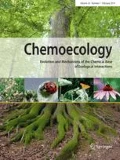Summary
Components of the green leaf volatile complex (Z-3-hexenyl acetate andE-2-hexenyl acetate) were shown to enhance responses of tobacco budworm,Heliothis virescens, males to the sex attractant pheromone of conspecific females in the field. The results are discussed with regard to green leaf volatiles which enhance the attractant pheromone of a cohabiting species, and serve as attractants of a parasitoid of conspecific larvae.
References
Bell WJ, Cardé RT (1984) Chemical Ecology of Insects. London: Chapman and Hall
Bedard WD, Tilden PE, Wood DL, Silverstein RM, Brownlee RG, Rodin JO (1969) Western pine beetle: field responses to its sex pheromone and a synergistic host terpene myrcene. Science 164:1284–1285
Borden JH (1985) Aggregation pheromones. Pp 257–285in Kerkut GA, Gilbert LI (eds) Comprehensive Insect Physiology Biochemistry and Pharmacology. Vol. 9. Behaviour. Elmsford/NY: Pergamon Press
Cantelo WW, Jacobson M (1979) Corn silk volatiles attract many pest species of moths. J Environ Sci Health A14:695–707
Cardé RT, Baker TC (1984) Sexual communication with pheromones. Pp 355–381in Bell WJ, Cardé RT (eds) Chemical Ecology of Insects. London: Chapman & Hall
Creighton CS, McFadden TL, Cuthbert ER (1973) Supplementary data on phenylacetaldehyde: an attractant for Lepidoptera. J Econ Entomol 66:114–117
Den Otter CJ, Thomas G (1979) Olfactory preference in insects: a synthesis of behaviour and electrophysiology. Pp 171–182in Kroeze JHA (ed.) Preference Behaviors and Chemoreception. London: Information Retrieval
Dickens JC (1989) Green leaf volatiles enhance aggregation pheromone of boll weevil,Anthonomus grandis. Entomol exp appl 52:191–203
Dickens JC, Jang EB, Light DM, Alford AR (1990) Enhancement of insect pheromone responses by green leaf volatiles. Naturwissenschaften 77:29–31
Duncan DB (1955) Multiple range and multiple F tests. Biometrics 11:1–42
Guérin PM, Städler E, Buser HR (1983) Identification of host plant attractants for the carrot fly,Psila rosae. J Chem Ecol 9:843–861
Hansson BS, Van Der Pers JNC, Löfqvist J (1989) Comparison of male and female olfactory cell response to pheromone compounds and plant volatiles in the turnip moth,Agrotis segetum. Physiol Entomol 14:147–155
Hatanaka A, Kajiwara T, Sekiya J (1987) Biosynthetic pathway for C6-aldehydes formation from linolenic acid in green leaves. Chem Phys Lipids 44:341–361
Katsoyannos BI, Guérin PM (1984) Hexanol: a potent attractant for the black fig fly.Silba adipata. Entomol exp appl 35:71–74
Klun JA, Plimmer JR, Bierl-Leonhardt BA, Sparks AN, Primiani M, Chapman OL, Lee GH, Lepone G (1980) Sex pheromone chemistry of female corn earworm moth,Heliothis zea. J Chem Ecol 6:165–175
Light DM, Flath RA, Buttery RG, Zalom FG, Rice RE, Dickens JC, Jang EB (1993) Host plant green leaf volatiles synergize the synthetic sex pheromones of the corn earworm and codling moth (Lepidoptera). Chemoecology 4:145–152
Ostle B (1963) Statistics in Research. Ames/Iowa: The Iowa State Univ Press
Rawaswamy SB, Randle SA, Ma WK (1985) Field evaluation of sex pheromone components ofHeliothis virescens (Lepidoptera: Noctuidae) in cone traps. Environ Entomol 14:293–296
Roelofs WL, Hill AS, Cardé RT, Baker TC (1974) Two sex pheromone components of the tobacco budworm moth,Heliothis virescens. Life Sci 14:1555–15562
Thompson AC, Baker DN, Gueldner RC, Hedin PA (1971) Identification and quantitative analysis of the volatile substances emitted by maturing cotton in the field. Plant Physiol 48:50–52
Tressl R, Bahri D, Engel K-H (1981) Lipid oxidation in fruits and vegetables. Pp 213–232in Teranishi R, Barrera-Benites H (eds) Quality of Selected Fruits of North America. ACS Symp Ser 170. Washington DC: Amer Chem Soc
Turlings TCJ, Tumlinson JH, Lewis WJ (1990) Exploitation of herbivore-induced plant odors by host-seeking parasitic wasps. Science 250:1251–1253
Van Der Pers JNC (1981) Comparison of electroantennogram response spectra to plant volatiles in seven species ofYponomeuta and in the tortricidAdoxophyes orana. Entomol exp appl 30:181–192
Visser JH, Ave DA (1978) General green leaf volatiles in the olfactory orientation of the Colorado beetle,Leptinotarsa decemlineata. Entomol exp appl 24:538–549
Visser JH, Van Straten S, Maarse H (1979) Isolation and identification of volatiles in the foliage of potato,Solanum tuberosum, a host plant of the Colorado beetle,Leptinotarsa decemlineata. J Chem Ecol 5:13–25
Whitman DW (1988) Plant natural products as parasitoid cuing agents. Pp 386–396in Cutler HD (ed.) Biologically Active Natural Products Potential Use in Agriculture. ACS Symp Ser 380. Washington DC: Amer Chem Soc
Whitman DW, Eller FJ (1990) Parasitic wasps orient to green leaf volatiles. Chemoecology 1:69–75
Youngman RR, Baker TC (1989) Host odor mediated response of female naval orangeworm moths (Lepidoptera: Pyralidae) to black and white sticky traps. J Econ Entomol 82:1339–1343
Author information
Authors and Affiliations
Rights and permissions
About this article
Cite this article
Dickens, J.C., Smith, J.W. & Light, D.M. Green leaf volatiles enhance sex attractant pheromone of the tobacco budworm,Heliothis virescens (Lep.: Noctuidae). Chemoecology 4, 175–177 (1993). https://doi.org/10.1007/BF01256553
Issue Date:
DOI: https://doi.org/10.1007/BF01256553

